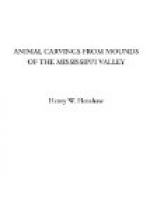Copies of several of the heads as they appear in “Ancient Monuments” (pp. 244-247) are here subjoined to show the various types of physiognomy illustrated by them:
[Illustration: Fig. 31. Fig. 32. Fig. 33. Human Carvings from the Mounds.]
[Illustration: Fig. 34. Fig. 35. Human Carvings from the Mounds.]
Could the many other stone and terra-cotta sculptures of the human face which have been ascribed to the Mound-Builders be reproduced here it would be seen that the specimens illustrated above are among the very best. In not a few, traces of the grotesque are distinctly visible, and there is little in their appearance to suggest that they had a different origin or contain a deeper meaning than similar productions found among present Indians. As each of the many carvings differ more or less from every other, it will at once be perceived that the advocates of different theories can readily find in the series abundant testimony in support of any and all assumptions they may choose to advance.
INDIAN AND MOUND-BUILDERS’ ART COMPARED.
Turning from special illustrations of the artistic skill of the Mound-Builders, brief attention may be paid to their art in its more general features, and as compared with art as found among our Indian tribes.
Among some of the latter the artistic instinct, while deriving its characteristic features, as among the Mound-Builders, from animated nature, exhibits a decided tendency towards the production of conventional forms, and often finds expression in creations of the most grotesque and imaginative character.
While this is true of some tribes it is by no means true of all, nor is it true of all the art products of even those tribes most given to conventional art. But even were it true in its broadest terms, it is more than doubtful if the significance of the fact has not been greatly overestimated. Some authors indeed seem to discern in the introduction of the grotesque element and the substitution of conventional designs of animals for a more natural portrayal, a difference sufficient to mark, not distinct eras of art culture merely, but different races with very different modes of art expression.




